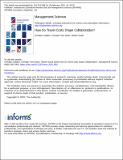How Do Travel Costs Shape Collaboration?
Author(s)
Catalini, Christian; Fons-Rosen, Christian; Gaulé, Patrick
DownloadPublished version (876.3Kb)
Publisher with Creative Commons License
Publisher with Creative Commons License
Creative Commons Attribution
Terms of use
Metadata
Show full item recordAbstract
We develop a simple theoretical framework for thinking about how geographic frictions, and in particular travel costs, shape scientists' collaboration decisions and the types of projects that are developed locally versus over distance. We then take advantage of a quasi-experiment-the introduction of new routes by a low-cost airline-to test the predictions of the theory. Results show that travel costs constitute an important friction to collaboration: after a low-cost airline enters, the number of collaborations increases between 0.3 and 1.1 times, a result that is robust to multiple falsification tests and causal in nature. The reduction in geographic frictions is particularly beneficial for high-quality scientists that are otherwise embedded in worse local environments. Consistent with the theory, lower travel costs also endogenously change the types of projects scientists engage in at different levels of distance. After the shock, we observe an increase in higher-quality and novel projects, as well as projects that take advantage of complementary knowledge and skills between subfields, and that rely on specialized equipment. We test the generalizability of our findings from chemistry to a broader data set of scientific publications and to a different field where specialized equipment is less likely to be relevant, mathematics. Last, we discuss implications for the formation of collaborative research and development teams over distance.
Date issued
2020-08Department
Sloan School of ManagementJournal
Management Science
Publisher
Institute for Operations Research and the Management Sciences (INFORMS)
Citation
Catalini, Christian et al. "How Do Travel Costs Shape Collaboration?" Management Science 66, 8 (August 2020): 3295-3798 © 2020 The Author(s)
Version: Final published version
ISSN
0025-1909
1526-5501